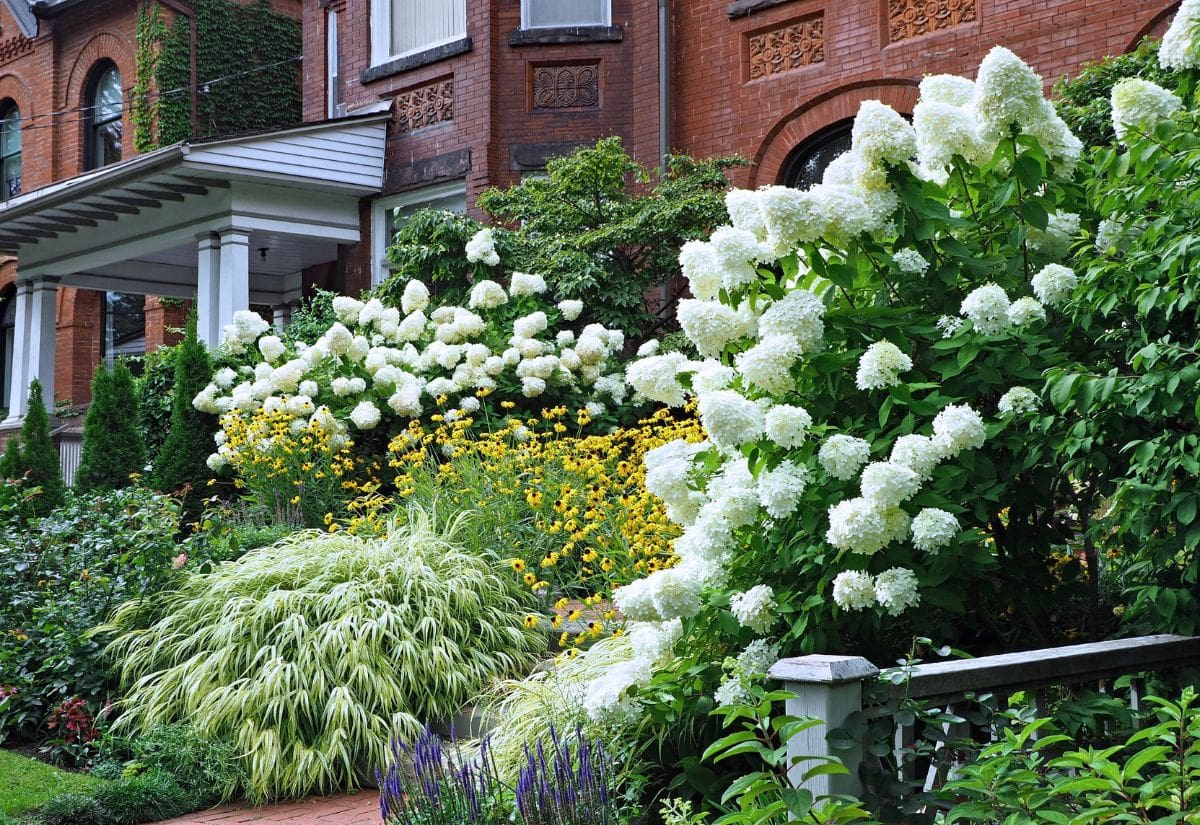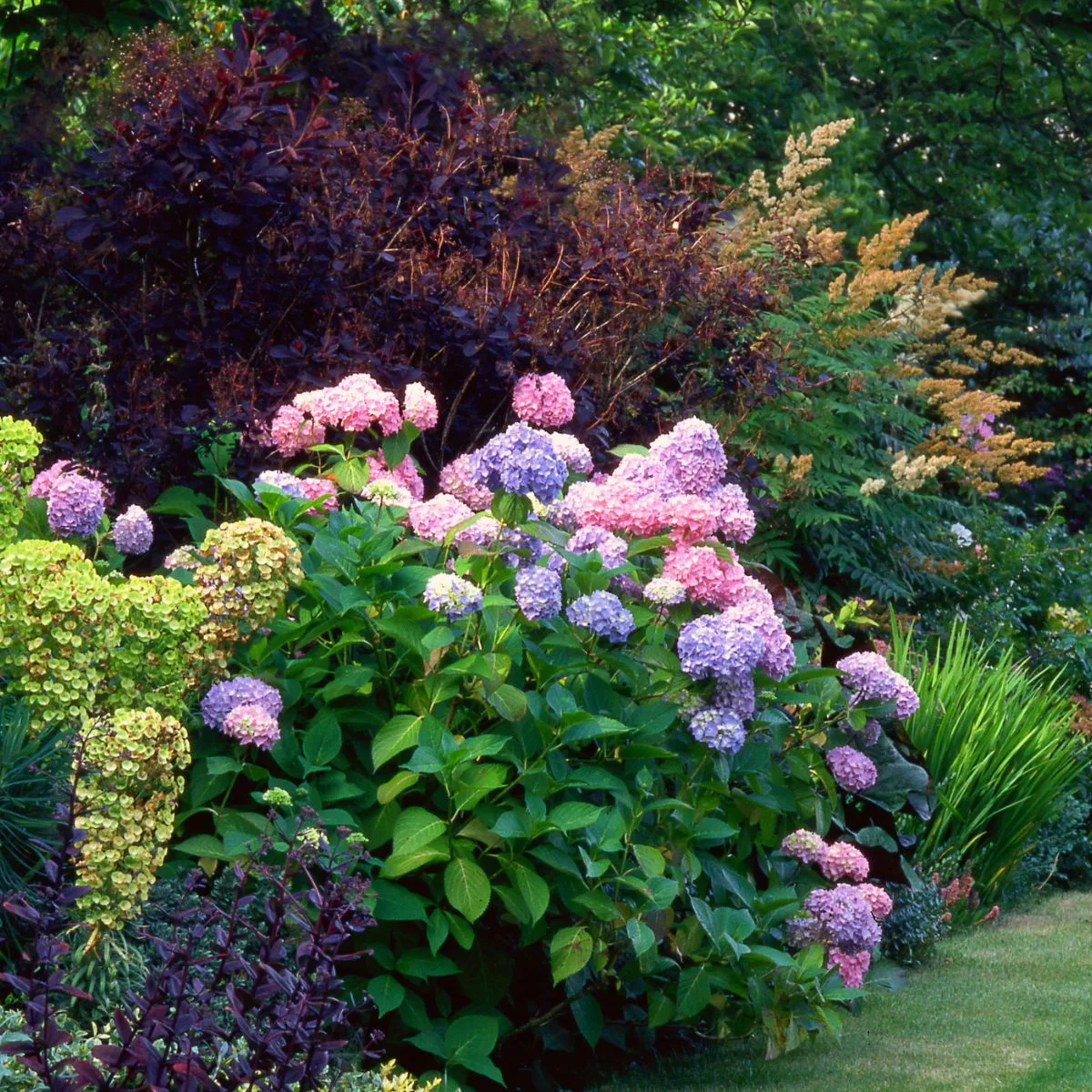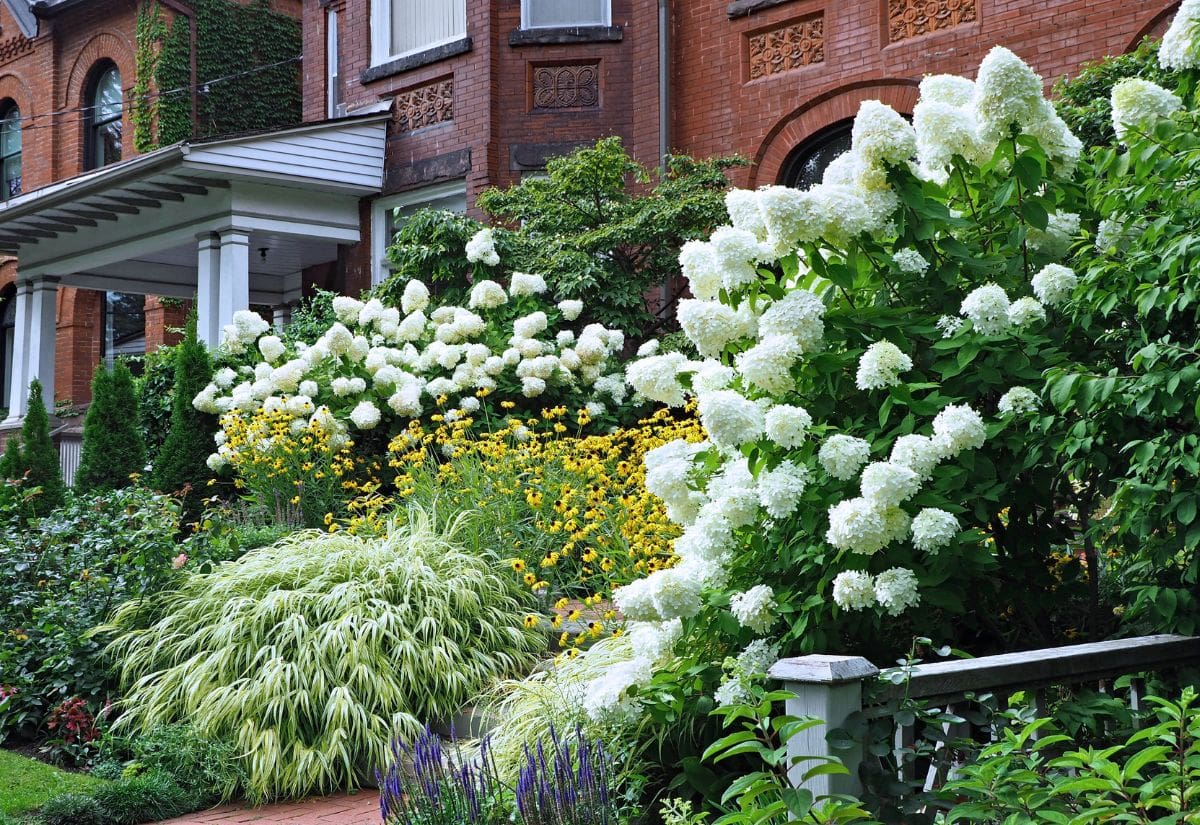How to Create a Hydrangea Garden With Edible Companion Plants: A captivating landscape design concept awaits! Imagine a vibrant garden brimming with colorful hydrangeas and delectable edible companions. This harmonious blend not only creates a visually stunning display but also offers a bounty of fresh produce and natural pest control.
This guide will equip you with the knowledge to design, plant, and care for a thriving hydrangea garden that seamlessly integrates edible delights.
Hydrangeas, known for their voluminous blooms and captivating hues, provide a stunning backdrop for a variety of edible companion plants. These companions, carefully selected for their complementary growth habits and beneficial properties, not only enhance the garden’s aesthetic appeal but also contribute to a healthier and more productive ecosystem.
From fragrant herbs to nutrient-rich vegetables, the possibilities are endless, creating a haven for both beauty and culinary delight.
Understanding Hydrangeas

Hydrangeas are a popular choice for gardeners due to their beautiful, showy blooms and versatility. They come in a variety of shapes, sizes, and colors, making them suitable for various garden styles. Understanding the different types of hydrangeas and their preferred growing conditions is crucial for creating a thriving hydrangea garden.
Hydrangea Types and Their Growing Conditions
Hydrangeas are classified into several different types, each with unique characteristics and growth requirements. Understanding these differences will help you select the best hydrangeas for your garden and ensure their success.
- Bigleaf Hydrangea (Hydrangea macrophylla): These are the most common type of hydrangea, known for their large, showy flower heads. Bigleaf hydrangeas prefer partial shade and moist, well-drained soil. They are also known for their ability to change flower color depending on the soil pH.
Acidic soil (pH below 6.0) produces blue flowers, while alkaline soil (pH above 7.0) produces pink flowers.
- Panicle Hydrangea (Hydrangea paniculata): These hydrangeas have cone-shaped flower heads that can reach up to 12 inches in length. They are more tolerant of full sun than other hydrangea types and prefer well-drained soil. Panicle hydrangeas are known for their long blooming period, extending from mid-summer to fall.
- Oakleaf Hydrangea (Hydrangea quercifolia): Oakleaf hydrangeas are named for their leaves, which resemble oak leaves. They prefer partial shade and acidic soil. Their flower heads are typically white or cream-colored and have a lacey appearance.
- Smooth Hydrangea (Hydrangea arborescens): Smooth hydrangeas are known for their large, white flower heads and their ability to tolerate full sun. They prefer moist, well-drained soil and are a good choice for gardeners in warmer climates.
- Climbing Hydrangea (Hydrangea anomala ssp. petiolaris): This type of hydrangea is a vine that can climb up to 50 feet tall. It prefers partial shade and moist, well-drained soil. Climbing hydrangeas are known for their beautiful white flowers and their ability to cover walls, fences, and other structures.
Characteristics of Hydrangeas That Make Them Appealing for Companion Planting
Hydrangeas are appealing companion plants for a variety of reasons.
- Attractive Blooms:Hydrangeas produce large, showy blooms that add color and interest to the garden.
- Diverse Shapes and Sizes:The variety of hydrangea types offers different shapes and sizes, allowing for diverse garden designs.
- Adaptability:Many hydrangea types are adaptable to various soil conditions and light levels.
- Pest and Disease Resistance:Hydrangeas are generally resistant to pests and diseases, making them low-maintenance plants.
Hydrangea Types, Bloom Colors, and Ideal Growing Conditions
Hydrangea Type |
Bloom Color |
Ideal Growing Conditions |
|---|---|---|
Bigleaf Hydrangea (Hydrangea macrophylla) |
Blue, pink, purple, white |
Partial shade, moist, well-drained soil, acidic soil for blue flowers, alkaline soil for pink flowers |
Panicle Hydrangea (Hydrangea paniculata) |
White, pink, green |
Full sun to partial shade, well-drained soil |
Oakleaf Hydrangea (Hydrangea quercifolia) |
White, cream |
Partial shade, acidic soil |
Smooth Hydrangea (Hydrangea arborescens) |
White |
Full sun to partial shade, moist, well-drained soil |
Climbing Hydrangea (Hydrangea anomala ssp. petiolaris) |
White |
Partial shade, moist, well-drained soil |
Edible Companion Plants for Hydrangeas

Companion planting, the practice of growing different plant species together to benefit each other, can be a valuable tool for hydrangea gardeners. By carefully selecting edible companion plants that thrive in similar growing conditions, you can enhance the health, growth, and overall beauty of your hydrangea garden.
Creating a vibrant hydrangea garden with edible companion plants requires careful planning, especially when it comes to protecting your bulbs from hungry critters. Just as you would safeguard fall-planted bulbs from squirrels and rabbits, How To Protect Fall-Planted Bulbs From Critters , you’ll need to consider the same strategies for your hydrangea garden.
This might include using protective netting or planting companion herbs known to deter pests, ensuring a bountiful harvest of both beautiful blooms and delicious edibles.
Benefits of Companion Planting for Hydrangeas, How to Create a Hydrangea Garden With Edible Companion Plants
Companion planting offers a range of benefits for hydrangeas, contributing to their growth and resilience.
- Pest Control:Some edible plants naturally repel pests that may target hydrangeas. For example, planting garlic or onions near hydrangeas can deter aphids and other insects.
- Pollination:Certain companion plants attract beneficial insects like bees and butterflies, which can aid in pollinating hydrangeas and increasing fruit production if you have fruiting hydrangeas.
- Soil Improvement:Companion plants can improve soil structure and fertility. For example, legumes like beans and peas fix nitrogen in the soil, providing a valuable nutrient for hydrangeas.
Edible Companion Plants for Hydrangeas
Here’s a table showcasing edible companion plants for hydrangeas, their benefits, and their ideal growing conditions:
Companion Plant |
Benefits |
Ideal Growing Conditions |
|---|---|---|
Garlic (Allium sativum) |
Repels aphids, spider mites, and other common garden pests. |
Full sun to partial shade, well-drained soil. |
Onions (Allium cepa) |
Similar pest-repelling properties as garlic. |
Full sun to partial shade, well-drained soil. |
Beans (Phaseolus vulgaris) |
Fix nitrogen in the soil, improving fertility for hydrangeas. |
Full sun, well-drained soil. |
Peas (Pisum sativum) |
Similar nitrogen-fixing benefits as beans. |
Full sun to partial shade, well-drained soil. |
Strawberries (Fragaria × ananassa) |
Attract beneficial insects like ladybugs and lacewings, which can help control pests. |
Full sun to partial shade, well-drained soil. |
Rosemary (Salvia rosmarinus) |
Repels whiteflies and other insects. |
Full sun, well-drained soil. |
Designing a Hydrangea Garden with Edible Companion Plants
Designing a hydrangea garden with edible companion plants involves careful planning and consideration of factors such as plant size, growth habits, and companion plant benefits. This approach not only creates a visually appealing garden but also enhances the health and productivity of both the hydrangeas and the edible plants.
Sample Garden Layout
A sample garden layout can be created by arranging hydrangeas and edible companion plants in a visually pleasing and functional way.
- Central Focus:A large hydrangea variety, such as ‘Annabelle’ or ‘Endless Summer,’ can be placed at the center of the garden to serve as a focal point. Its large flower heads will draw the eye and provide a dramatic backdrop for the surrounding plants.
- Border Plants:Edible companion plants, such as herbs like rosemary, thyme, or lavender, can be planted around the perimeter of the garden to create a defined border and provide fragrance and pest control. These herbs can also be interspersed with smaller hydrangea varieties for added visual interest.
- Backdrops and Fillers:Taller edible plants, such as asparagus, rhubarb, or tomatoes, can be planted in the background to provide a backdrop for the hydrangeas and add height to the garden. Smaller edible plants, such as lettuce, spinach, or strawberries, can be used as fillers to create a lush and vibrant garden.
Spacing and Arrangement
Spacing and arrangement are crucial for the success of any garden.
- Hydrangea Spacing:Hydrangeas typically require 3-5 feet of spacing between plants to allow for adequate air circulation and root growth. Smaller hydrangea varieties, such as ‘Pee Wee’ or ‘Little Lamb,’ may require less spacing.
- Companion Plant Spacing:Edible companion plants should be spaced according to their specific needs. Herbs generally require less space than vegetables, while taller vegetables, such as tomatoes or peppers, will need more room to grow.
- Arranging Plants:When arranging plants, consider the mature size of each plant and the amount of sunlight they require. Plants that prefer similar growing conditions should be grouped together.
Tips for Visual Appeal and Space Utilization
- Varying Heights and Textures:Incorporate a variety of plant heights and textures to create visual interest. This can be achieved by using a combination of tall hydrangeas, smaller hydrangea varieties, and edible companion plants with different leaf shapes and sizes.
- Color Combinations:Choose hydrangeas and edible companion plants that complement each other in color. For example, pink hydrangeas can be paired with red lettuce or purple basil, while blue hydrangeas can be paired with yellow squash or green beans.
- Vertical Gardening:Maximize space utilization by incorporating vertical gardening techniques. This can be done by using trellises or stakes to support vining vegetables, such as cucumbers or beans, or by planting herbs in hanging baskets.
Caring for a Hydrangea Garden with Edible Companion Plants
A flourishing hydrangea garden with edible companion plants requires consistent care to ensure the health and productivity of both types of plants. Understanding the specific needs of each plant group is crucial for creating a thriving ecosystem.
Watering and Fertilizing
Hydrangeas and edible companion plants have varying watering requirements. Hydrangeas prefer consistently moist soil, especially during the growing season. They benefit from deep watering, allowing the water to penetrate the root system. On the other hand, many edible companion plants, like herbs, are drought-tolerant and prefer well-drained soil.
- Hydrangeas:Water deeply and consistently, especially during dry spells. Aim for 1-2 inches of water per week.
- Edible Companion Plants:Water moderately, allowing the soil to dry slightly between waterings. Avoid overwatering, which can lead to root rot.
Fertilizing is also essential for the health and vigor of both hydrangeas and edible companion plants.
- Hydrangeas:Fertilize hydrangeas in early spring with a balanced fertilizer, such as 10-10-10. Avoid excessive nitrogen, which can promote foliage growth at the expense of blooms.
- Edible Companion Plants:Use organic fertilizers, such as compost or manure, to enrich the soil and provide essential nutrients for the plants. Avoid using synthetic fertilizers, which can harm beneficial soil microbes.
Pruning
Pruning is crucial for maintaining the shape and health of hydrangeas.
Creating a hydrangea garden with edible companion plants can be a beautiful and delicious endeavor. Just like you can plan for spring blooms by planting bulbs in the fall, as outlined in this comprehensive guide on How To Design Your Garden Using Spring Flowering Bulbs Planted In Fall , you can also plan your hydrangea garden for success by selecting companion plants that will enhance the soil and attract beneficial insects, creating a thriving ecosystem.
- Hydrangeas:Prune hydrangeas in late winter or early spring before new growth emerges. Remove dead, diseased, or damaged branches. For older hydrangeas, consider thinning out the center of the plant to improve air circulation and light penetration.
- Edible Companion Plants:Prune edible companion plants regularly to encourage growth and prevent overcrowding. For herbs, pinch back the tips of stems to promote bushier growth and increase the yield of leaves.
Pest and Disease Management
Both hydrangeas and edible companion plants are susceptible to various pests and diseases.
- Hydrangeas:Common pests include aphids, spider mites, and Japanese beetles. Diseases include powdery mildew and leaf spot.
- Edible Companion Plants:Common pests include aphids, whiteflies, and caterpillars. Diseases include powdery mildew, rust, and blight.
To prevent and control pests and diseases, consider these natural methods:
- Encourage beneficial insects:Attract beneficial insects, such as ladybugs and lacewings, by planting flowering plants, providing nesting materials, and avoiding the use of pesticides.
- Use insecticidal soap or neem oil:Apply insecticidal soap or neem oil to control pests. These solutions are less harmful to beneficial insects than conventional pesticides.
- Practice good sanitation:Remove and dispose of diseased or infected plant material promptly to prevent the spread of diseases.
- Rotate crops:Rotate edible companion plants annually to break the cycle of pests and diseases.
Harvesting and Enjoying Edible Companions: How To Create A Hydrangea Garden With Edible Companion Plants
The rewards of your hard work in creating a hydrangea garden with edible companions are ready to be enjoyed. Harvesting your edible companions at their peak ensures the best flavor and quality.
Harvesting at Peak Ripeness
Harvesting edible companion plants at their peak ripeness is essential for maximizing flavor and nutritional value. Here’s a guide for harvesting various common edible companions:
- Leafy Greens:Harvest lettuce, spinach, and kale when the leaves are young and tender, before they become bitter. Cut the leaves at the base, leaving the plant to regrow.
- Herbs:Harvest herbs like basil, oregano, and thyme before they flower, as the leaves will be more flavorful. Pinch off leaves or stems as needed, allowing the plants to continue growing.
- Tomatoes:Harvest tomatoes when they are fully red and firm. For smaller cherry tomatoes, harvest when they are firm and brightly colored.
- Peppers:Harvest peppers when they are firm and brightly colored, depending on the variety. Green peppers can be harvested when they are fully grown, but red peppers are sweeter and more flavorful when ripe.
- Beans:Harvest snap beans when they are young and tender. For string beans, harvest when the pods are fully grown but still tender.
- Strawberries:Harvest strawberries when they are fully red and plump. Pick the berries gently to avoid damaging the plant.
Preparing and Using Harvested Produce
- Salads:Combine fresh herbs, leafy greens, and edible flowers for a vibrant and flavorful salad.
- Soups and Stews:Add herbs, tomatoes, and peppers to enhance the flavor of soups and stews.
- Sauces and Dressings:Use fresh herbs and spices to create delicious sauces and dressings.
- Pickling and Preserving:Preserve the bounty of your harvest by pickling cucumbers, peppers, and beans, or preserving herbs in oil or vinegar.
- Infused Oils and Vinegars:Create flavorful infused oils and vinegars by adding fresh herbs and spices.
Culinary Ideas
- Tomato and Basil Bruschetta:Top toasted bread with chopped tomatoes, basil, garlic, and olive oil for a classic appetizer.
- Strawberry and Basil Salad:Combine fresh strawberries, basil, and balsamic vinegar for a refreshing summer salad.
- Lemon-Herb Roasted Chicken:Roast chicken with lemon, rosemary, thyme, and garlic for a flavorful and aromatic dish.
- Pepper and Tomato Salsa:Combine chopped peppers, tomatoes, onions, cilantro, and lime juice for a zesty salsa.
- Pea and Mint Soup:Puree fresh peas, mint, and vegetable broth for a light and refreshing soup.
Closing Notes
Creating a hydrangea garden with edible companions is an enriching journey that combines the artistry of landscape design with the practicality of sustainable gardening. By understanding the unique needs of both hydrangeas and their edible counterparts, you can create a flourishing haven that delights the senses and nourishes the soul.
As you cultivate this harmonious garden, you’ll not only enjoy the vibrant blooms and delicious harvests but also contribute to a thriving ecosystem that benefits both your family and the environment.
FAQ Guide
What are the best hydrangea varieties for companion planting?
The best hydrangea varieties for companion planting are those that thrive in similar growing conditions to the edible plants you choose. For example, oakleaf hydrangeas, known for their tolerance to partial shade, pair well with shade-loving vegetables like lettuce and spinach.
How do I prevent pests and diseases in my hydrangea garden?
Preventing pests and diseases in your hydrangea garden involves a combination of good cultural practices and natural control methods. Ensure proper spacing for good air circulation, water consistently, and avoid over-fertilizing. Introduce beneficial insects like ladybugs and lacewings to control aphids and other pests.
What are some tips for harvesting edible companion plants?
Harvest edible companion plants at their peak ripeness for the best flavor and nutritional value. Use sharp scissors or pruning shears to make clean cuts, avoiding damaging the plant. Consider using companion planting techniques like intercropping, where you plant different crops in close proximity to each other, to maximize space and yield.
